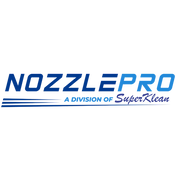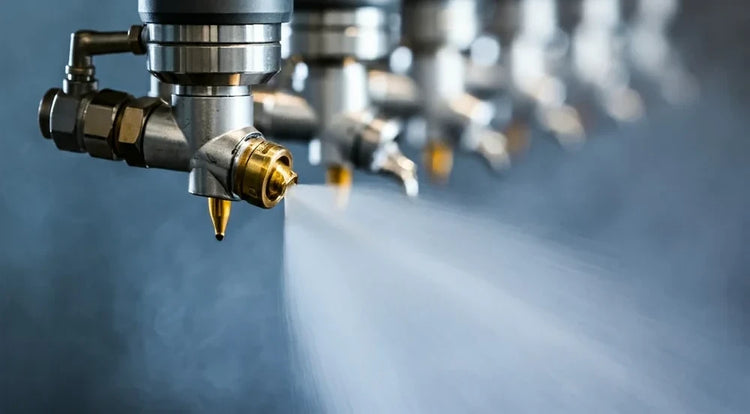To view pricing, please fill the form added below.
Already have an account? Please Login here.Belt Cleaning Spray Nozzles for Mining
Carryback grinds bearings, overloads idlers, and contaminates product. NozzlePro's high-impact belt wash bars remove fines and sticky clays at the head pulley, return run, and transfer points—cutting maintenance costs, extending belt life 40–60%, and maintaining consistent throughput in harsh mining environments.
Effective belt cleaning integrates precision spray systems with mechanical scrapers, creating a two-stage attack on adherent material. Scrapers provide the initial impact; optimized wash bars finish the job with perfectly angled, overlapped spray coverage. The result: cleaner belts, longer bearing life, reduced spillage, and 30–50% lower maintenance costs.
The Belt Carryback Challenge
Material buildup on conveyor belts happens in three zones:
- Head Pulley (Discharge): Bulk carryback adheres to belt carrying surface—largest volume, requires highest impact
- Return Run: Residual fines stick to underside—prevents idler/bearing fouling, requires continuous low-pressure spray
- Transfer Points & Chutes: Material migrates to structural surfaces—housekeeping spray prevents spillage and cross-contamination
Left unchecked, carryback causes: increased motor loads (5–15% power rise), bearing failures (2–4 year life vs 5–8 years), belt deterioration (18–24 month service vs 30–40 months), tracking problems, spillage incidents, and unplanned production shutdowns costing thousands per hour.
Belt Cleaning Applications
Strategic nozzle placement targets the three primary carryback zones, using different spray patterns and pressures optimized for each challenge:
Primary Head Pulley Wash
High-impact flat-fan spray bars positioned immediately after the primary scraper remove bulk carryback before it migrates to return idlers. Wide coverage (110–130% overlap) at 40–70 bar ensures complete belt width treatment. Reduces carryback entering return run by 85–95%.
Flat Fan Nozzles →Return Belt Secondary Rinse
Lower-pressure full-cone or flat-fan spray systems clean the return (underside) belt surface and prevent fines accumulation on return idlers. Operates continuously or on-demand at 3–15 bar, maintaining clean idlers that preserve bearing life and prevent tracking problems.
Full Cone Nozzles →Idler & Roller Cleaning
Focused high-pressure solid-stream or flat-fan jets target return idlers, snub pulleys, and bend rollers to remove embedded fines. Prevents material binding that causes bearing seizure, belt mistracking, and vibration. Applied during maintenance windows or continuously at lower pressures.
Solid Stream Jets →Transfer Point Dust & Spillage Control
Spray systems at transfer chutes, loading zones, and boot areas contain material migration, suppress dust generation (MSHA compliance), and clean structural surfaces. Hollow cone or low-pressure full cone creates gentle coverage without disturbing belt operation.
Dust Control Solutions →Scraper Pre-Wetting Integration
Precision nozzle positioned upstream of primary scraper blade pre-softens sticky clays, breaks surface tension of fines, and reduces blade contact pressure. Improves scraper efficiency 30–50% while extending blade life 2–4× through reduced wear and loading.
Pre-Wet Systems →Automated Motion-Activated Cleaning
PLC-controlled systems with proximity sensors or speed monitors activate spray only during belt operation, optimizing water usage 40–70%. Flow meters and manual override enable field adjustments. Reduces water consumption from 500+ L/min continuous to 200–300 L/min demand-based operation.
Automated Systems →Benefits of Engineered Belt Cleaning
- Extended Belt Life 40–60% — Clean belts avoid abrasive wear from trapped fines, extending service from 18–24 months to 30–40 months
- Reduced Component Failure 30–50% — Preventing idler/bearing fouling cuts maintenance incidents and emergency replacements
- Lower Power Consumption 5–15% — Cleaner idlers and reduced rolling resistance decrease motor loads and energy costs
- Improved Throughput & Reliability — Elimination of spillage, tracking problems, and unplanned shutdowns maintains rated capacity
- Cross-Contamination Prevention — Effective belt cleaning between ore types, coal seams, or product changes maintains specifications
- Worker Safety & MSHA Compliance — Reduced spillage eliminates slip hazards; dust suppression improves air quality
- Water Efficiency & Cost Reduction — Automated systems reduce water consumption 40–70% vs continuous spray
Nozzle Selection: Patterns & Pressure
Understanding Spray Patterns for Belt Applications
Flat Fan (High Impact)
Best for: Head pulley primary wash, scraper pre-wetting, stubborn carryback removal.
Characteristics: Linear concentration of spray energy, 60–110° angles, maximum impact force (15–40 N/cm² at 40–70 bar).
Why It Works: Direct perpendicular impingement dislodges adherent material more effectively than dispersed patterns.
Explore Flat Fan →Full Cone (Uniform Coverage)
Best for: Return run secondary washing, general housekeeping, transfer point spray.
Characteristics: Even 360° distribution, 25–90° spray angles, moderate impact force (8–15 N/cm²).
Why It Works: Consistent coverage without gaps; predictable overlap patterns; lower water usage for secondary cleaning.
Explore Full Cone →Solid Stream (Maximum Penetration)
Best for: Idler cleaning, roller decontamination, focused jet cleaning of accumulation zones.
Characteristics: Concentrated beam, extended range, highest impact energy (40–80 N/cm² at high pressure).
Why It Works: Cuts through stubborn deposits on roller grooves; penetrates hard-to-reach bearing areas.
Explore Solid Stream →Hollow Cone (Fine Mist)
Best for: Dust suppression, transfer point housekeeping, gentle cleaning without saturation.
Characteristics: Ring-shaped spray, 30–90° angles, minimal flow concentration (3–8 N/cm²).
Why It Works: Captures airborne dust, cleans structures without flooding; reduces water consumption.
Explore Hollow Cone →Pressure Optimization
Pressure drives cleaning effectiveness. Higher pressure = greater impact force = better carryback removal. However, excessive pressure wastes water and can damage belt covers or seals.
| Application Zone | Optimal Pressure | Impact Force | Material Type |
|---|---|---|---|
| Head Pulley Primary Wash | 40–70 bar (580–1,015 PSI) | 20–40 N/cm² | Flat fan at high angle |
| Return Belt Rinse | 5–15 bar (73–218 PSI) | 3–8 N/cm² | Full cone, low angle |
| Idler / Roller Cleaning | 50–100 bar (725–1,450 PSI) | 35–60 N/cm² | Solid stream, tight angle |
| Transfer Point Dust | 8–20 bar (116–290 PSI) | 5–12 N/cm² | Hollow cone, full angle |
| Scraper Pre-Wetting | 10–20 bar (145–290 PSI) | 4–10 N/cm² | Flat fan, fine spray |
Material-Specific Cleaning Challenges
Coal & Lignite
Challenge: High moisture (5–35%) + fine adherence create sticky carryback.
Solution: Moderate pressure 20–40 bar with wide-angle flat fans. Synchronize spray with belt speed for efficient material removal without over-saturation.
Iron Ore & Taconite
Challenge: High density (4.5–5.2 sp.gr.) + fine particles require aggressive impact.
Solution: Higher pressure 40–70 bar. Use hardened stainless or tungsten carbide tips for durability against abrasive fines.
Clay-Rich Ores
Challenge: Sticky, plastic clays resist mechanical removal and require sustained dwell time.
Solution: Two-stage approach: pre-wet at 10–15 bar to soften, then primary wash at 50–70 bar. Consider warm water (40–60°C) in cold climates.
Aggregates & Crushed Stone
Challenge: Lower moisture + minimal adhesion = simpler cleaning profile.
Solution: Lower pressure 15–30 bar sufficient. Motion-activated spray conserves water while maintaining carryback control.
Phosphate Rock & Specialty Ores
Challenge: Variable moisture + unique particle morphology affect cleaning effectiveness.
Solution: Pilot testing during commissioning. NozzlePro can recommend optimal pressure and pattern based on your specific material.
Nozzle Material Selection
Standard SS316: 200+ hours life in low-abrasion coal cleaning.
Hardened SS316L: 500–1,500 hours in moderate abrasion (most mining applications).
Tungsten Carbide: 2,000–5,000 hours in extreme abrasion (iron ore, taconite, silica-rich materials).
How We Size Your Belt Wash System
Coverage, Overlap & Redundancy
Step 1: Belt Width → Nozzle Count
Determine effective coverage per nozzle at your spray angle and standoff. Example: 65° flat fan at 0.5m standoff = 0.7m effective coverage. For 2.0m belt: 3–4 nozzles per row with 10–30% overlap.
Step 2: Material Type → Pressure Selection
Start with base pressure (40–50 bar for iron ore, 20–35 bar for coal). Test during pilot run; increase pressure only if carryback remains, never increase flow first.
Step 3: Belt Speed & Load → Row Count
Faster belts (4–6 m/s) need tighter spacing or additional rows. Heavy loads need higher pressure. Multi-row staggered arrays (2–3 rows) improve coverage redundancy.
Step 4: Water Balance → Flow Optimization
Calculate total flow needed for all rows; match to available pump capacity. Optimize via pressure adjustment rather than adding nozzles.
Step 5: Automation & Control
Specify manual on/off, timer-based, or motion-sensor activation. Consider PLC integration for data logging and predictive maintenance.
Typical Sizing Example
Scenario: 1,400mm conveyor, 5 m/s belt speed, iron ore with clay fines, 8,000 tons/hour.
Recommendation: Two rows of primary wash (head pulley discharge): 4 wide-angle (80°) flat fans per row at 60 bar, 1.5 GPM each = 12 GPM total. Secondary return rinse: 2 full cones at 10 bar, 2 GPM each = 4 GPM. Total system: 16 GPM at 60 bar average. Pump requirement: ~30 hp. Expected carryback elimination: 90–95%.
Typical Sizing Ranges
| Application Zone | Nozzle Pattern | Pressure | Flow / Nozzle | Collection |
|---|---|---|---|---|
| Head Pulley Primary (High-Impact) | Flat Fan (65–85°) | 40–70 bar | 1–3 GPM | Flat Fan |
| Return Run Secondary Rinse | Full Cone (25–90°) | 5–15 bar | 0.8–2 GPM | Full Cone |
| Idler & Roller Cleanup | Solid Stream / High-Pressure Fan | 50–100 bar | per sizing | Solid Stream |
| Transfer Point Housekeeping | Hollow Cone (40–90°) | 8–20 bar | 0.5–2 GPM | Hollow Cone |
| Scraper Pre-Wetting | Fine Spray Flat Fan | 10–20 bar | 0.3–1 GPM per meter | Flat Fan |
Note: All values depend on belt width, speed, material type, scraper configuration, available water quality, and your allowable water balance. NozzlePro provides detailed system sizing, manifold layouts, hydraulic calcs, and material recommendations after analyzing your specific conveyor specifications.
Complete Your Mining Belt Program
Design a comprehensive conveyor system across cleaning, dust control, ore washing, and thermal management.

